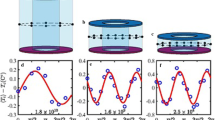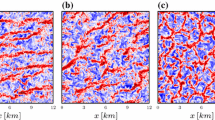Abstract
Two mechanisms of roll initiation are highlighted in a horizontal channel flow, uniformly heated from below, at constant heat flux (Γ = 10, Pr = 7, 50 ≤ Re ≤ 100, 0 ≤ Ra ≤ 106). The first mechanism is the classical one, it occurs for low Rayleigh numbers and is initiated by the lateral wall effect. The second occurs for higher Rayleigh numbers and combines the previous effect with a supercritical vertical temperature gradient in the lower boundary layer, which simultaneously triggers pairs of rolls in the whole zone in between the two lateral rolls. We have found that in the present configuration, the transition between the two roll initiation mechanisms occurs for Ra/Re 2 ≈ 18. Consequently, the heat transfer is significantly enhanced compared to the pure forced convection case owing to the flow pattern responsible of the continuous flooding the heated wall with cold fluid.














Similar content being viewed by others
Abbreviations
- b :
-
channel width (m)
- g :
-
gravitational acceleration constant (m s−2)
- h :
-
channel height (m)
- k :
-
thermal conductivity of water (W m−1 K−1)
- L :
-
channel dimensionless length
- l :
-
channel length (m)
- l e :
-
development length (m)
- Le :
-
dimensionless development length
- n :
-
outward unit vector
- Nu :
-
Nusselt number, q h /k(T sa−T av)
- P :
-
dimensionless dynamic pressure
- Pr :
-
Prandtl number, ν/α
- q :
-
constant heat flux density at the bottom wall (W m−2)
- Ra :
-
Rayleigh number, gβh 4 q/kvα
- Re :
-
Reynolds number, u av h/ν
- T :
-
temperature (K)
- U, V, W :
-
dimensionless velocity components, in X, Y, Z directions, u/u av, v/u av , w/u av
- u av :
-
mean longitudinal velocity (m/s)
- X, Y, Z :
-
dimensionless coordinates, x/h, y/h, z/h
- α :
-
thermal diffusivity (m2 s−1)
- β :
-
volumetric thermal expansion coefficient (K−1)
- Γ :
-
spanwise aspect ratio, b/h
- ρ :
-
fluid density (kg m−3)
- μ :
-
dynamic viscosity of water (kg m−1 s−1)
- ν :
-
kinematic viscosity of water (m2 s−1)
- θ :
-
dimensionless temperature, (T − T i)k/(q h)
- av:
-
average value
- c:
-
central
- cr:
-
critical
- i:
-
inlet quantities
- ref:
-
reference
- sa:
-
spanwise average
References
Mori Y, Uchida Y (1966) Forced convection heat transfer between horizontal flat plate. Int J Heat Mass Transf 9:803–817
Ostrach S, Kamotani Y (1975) Heat transfer augmentation in laminar fully developed channel flow by means of heating from below. ASME J Heat Transf 97:220–225
Kamotani Y, Ostrach S (1976) Effect of thermal instability on thermally developing laminar channel flow. ASME J Heat Transf 98:62–66
Kamotani Y, Ostrach S, Miao H (1979) Convective heat transfer augmentation by means of thermal instability. ASME J Heat Transf 101:222–226
Gage KS, Reid WH (1968) The stability of thermally stratified plane Poiseuille flow. J fluid mech 33:21–32
Luijkx JM, Platten JK, Legros JC (1981) On the existence of thermoconvective rolls, transverse to a superimposed mean Poiseuille flow. Int J Heat Mass Transf 24:1287–1291
Ouazzani MT, Caltagirone JP, Meyer G, Mojtabi A (1989) Etude numérique et expérimentale de la convection mixte entre deux plans horizontaux à températures différentes. Int J Heat Mass Transf 32:261–269
Ouazzani MT, Platten JK, Mojtabi A (1990) Etude expérimentale de la convection mixte entre deux plans horizontaux à temperatures différentes-II. Int J Heat Mass Transf 33:1417–1427
Nicolas X, Mojtabi A, Platten JK (1997) Two dimensional numerical analysis of the Poiseuille–Bénard flow in a rectangular channel heated from below. Phys Fluids 9:337–348
Nicolas X (2002) Revue bibliographique sur les écoulements de Poiseuille Rayleigh Bénard: écoulements de convection mixte en conduites rectangulaires horizontales chauffées par le bas International. J Therm Sci 41:961–1016
Carrière P, Monkewitz PA (1999) Convective versus absolute instability in mixed Rayleigh–Bénard Poiseuille convection. J Fluid Mech 384:243–262
Pabiou H, Mergui S, Bénard C (2005) Wavy secondary instability of longitudinal rolls in Rayleigh–Bénard–Poiseuille flows. J Fluid Mech 542:175–194
Clever RM, Busse FH (1991) Instabilities of longitudinal rolls in a fluid of moderate Prandtl number. J Fluid Mech 91:319–335
Maughan JR, Incropera FP (1987) Experiments on mixed convection heat transfer for airflow in a horizontal rectangular and inclined channel. Int J Heat Mass Transf 30:1307–1318
Maughan JR, Incropera FP (1990) Regions of heat transfer enhancement for laminar mixed convection in a parallel plate channel. Int J Heat Mass Transf 33:555–570
Incropera FP, Knox AL, Schutt JA (1986) Onset of thermally driven secondary flow in horizontal rectangular duct. Int. Heat Transfer Conf. vol. 3 San Francisco, CA USA, pp 1395–1400
Maughan JR, Incropera FP (1987) Secondary flow in horizontal channels heated from below. Exp Fluids 5:334–343
Incropera FP, Knox AL, Maughan JR (1987) Mixed convection flow and heat transfer in the entry region of a horizontal rectangular duct. J Heat Transf 109:434–439
Liu CW, Gau C (2004) Onset of secondary flow and enhancement of heat transfer in horizontal convergent and divergent channels heated from below. Int J Heat Mass Transf 47:5427–5438
Gau C, Liu CW, Huang TM, Aung W (1999) Secondary flow enhancement of heat transfer in horizontal parallel-plate and convergent channels heating from below. Int J Heat Mass Transf 42:2629–2647
Kim MC, Chung TJ, Choi CK (2003) The onset of convective instability in the thermal entrance region of plane Poiseuille flow heated uniformly from below. Int J Heat Mass Transf 46:2629–2636
Park JH, Chung TJ, Yun ES, Kim MC, Choi CK (2006) The onset of longitudinal vortex rolls in the thermal entrance region of plane Poiseuille flow heated with a constant heat flux. Int J Heat Mass Transf 49:3708–3716
Bonnefoi C, Abid C, Medale M, Papini F (2004) Poiseuille–Bénard instability in a horizontal rectangular duct water flow. Int J Therm Sci 43:791–796
Abid C, Médale M, Papini F, Cerisier P (2006) Mixed convection in a horizontal rectangular duct heated from below. Int J Low Carbon Technol 1(3):236–244
Gray DD, Giorgini A (1976) The validity of the Boussinesq approximation for liquids and gases. Int J Heat Mass Transfer 19:545–551
Nicolas X, Luijkx JM, Platten JK (2000) Linear stability of mixed convection flows in horizontal rectangular channels of finite transversal extension heated from below. Int J Heat Mass Transf 43:589–610
Papanastasiou TC, Malamataris N, Ellwood K (1992) A new outflow boundary condition. Int J Num Meth Fluids 14:587–608
De Boer PCT (1984) Thermally driven motion of strongly heated fluids. Int J Heat Mass Transf 27:2239–2252
Perry’s, Chemical engineers’ handbook. (1997) Mc Graw-Hill
Medale M, Cerisier P (2002) Numerical simulation of Bénard-Marangoni convection in small aspect ratio containers. Num Heat Trans A 42:55–72
Guermond JL, Shen J (2003) A new class of truly consistent splitting schemes for incompressible flows. J Comp Phys 192:262–276
Balay S, Buschelman K, Gropp WD, Kaushik D, Knepley MG, Curfman McInnes L, Smith BF, Zhang H (2007) Petsc web pages, http://www.mcs.anl.gov/petsc
Incropera FP, Dewitt DP (1996) Fundamentals of heat and mass transfer, John Wiley Edition, 4th edn, USA
Acknowledgments
The authors thank The CNRS for providing substantial computer resources on its IBM SP4 high performance computer at IDRIS, Orsay, France.
Author information
Authors and Affiliations
Corresponding author
Appendix : Determination of appropriate mesh resolution
Appendix : Determination of appropriate mesh resolution
To save computational solution time the spatial convergence analysis has been conducted for a steady state configuration, which corresponds to the following set of control parameters: Pr = 6.7, Re = 50 and Ra = 1.28 × 104. Taking advantage that this configuration leads to a symmetric longitudinal roll pattern with respect to the longitudinal vertical median plane, one can therefore consider a computational domain restricted to only one half of the physical domain. We have considered for this spatial convergence analysis three meshes discretizing one half of the physical domain, while considering symmetry boundary conditions over the longitudinal vertical median plane. The three meshes are made up of tri-quadratic hexahedral finite elements, uniformly distributed along the X, Y and Z directions, respectively. Their individual description is given in Table 1.
Let us compare the results obtained for three meshes, qualitatively and quantitatively. First of all, one can observe the isotherms at the lower heated wall compare qualitatively well between the coarsest and finest meshes in Fig. 15 or between the intermediate and finest meshes in Fig. 16. Moreover, we have also compared quantitatively the results obtained from the three considered meshes. The spanwise temperature profile is also plotted at three longitudinal locations, cf. Fig. 17a, and finally the spanwise vertical velocity component is also plotted for the three meshes, at mid channel height at three longitudinal locations, cf. Fig. 17b. Finally, we have compared for higher Rayleigh number (Re = 50, Ra = 5.13 × 104), the spanwise average Nusselt number versus the longitudinal direction for two mesh resolutions (M1 and M3). One can observe that the coarser mesh slightly overestimates the Nusselt number (less 4%) and underestimates the roll development length (less than 6%). One can conclude from theses Figs. 15–18 that the three meshes are qualitatively able to represent the present mixed convection and moreover spatial convergence has been already reached for mesh M2, since no substantial difference can be observed compared to the finest mesh M3.
Rights and permissions
About this article
Cite this article
Benderradji, A., Haddad, A., Taher, R. et al. Characterization of fluid flow patterns and heat transfer in horizontal channel mixed convection. Heat Mass Transfer 44, 1465–1476 (2008). https://doi.org/10.1007/s00231-008-0379-3
Received:
Accepted:
Published:
Issue Date:
DOI: https://doi.org/10.1007/s00231-008-0379-3








